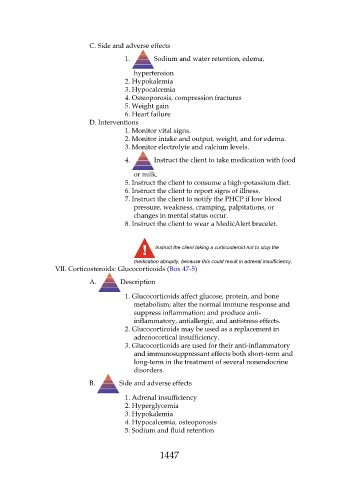Page 1447 - Saunders Comprehensive Review For NCLEX-RN
P. 1447
C. Side and adverse effects
1. Sodium and water retention, edema,
hypertension
2. Hypokalemia
3. Hypocalcemia
4. Osteoporosis, compression fractures
5. Weight gain
6. Heart failure
D. Interventions
1. Monitor vital signs.
2. Monitor intake and output, weight, and for edema.
3. Monitor electrolyte and calcium levels.
4. Instruct the client to take medication with food
or milk.
5. Instruct the client to consume a high-potassium diet.
6. Instruct the client to report signs of illness.
7. Instruct the client to notify the PHCP if low blood
pressure, weakness, cramping, palpitations, or
changes in mental status occur.
8. Instruct the client to wear a MedicAlert bracelet.
Instruct the client taking a corticosteroid not to stop the
medication abruptly, because this could result in adrenal insufficiency.
VII. Corticosteroids: Glucocorticoids (Box 47-5)
A. Description
1. Glucocorticoids affect glucose, protein, and bone
metabolism; alter the normal immune response and
suppress inflammation; and produce anti-
inflammatory, antiallergic, and antistress effects.
2. Glucocorticoids may be used as a replacement in
adrenocortical insufficiency.
3. Glucocorticoids are used for their anti-inflammatory
and immunosuppressant effects both short-term and
long-term in the treatment of several nonendocrine
disorders.
B. Side and adverse effects
1. Adrenal insufficiency
2. Hyperglycemia
3. Hypokalemia
4. Hypocalcemia, osteoporosis
5. Sodium and fluid retention
1447

